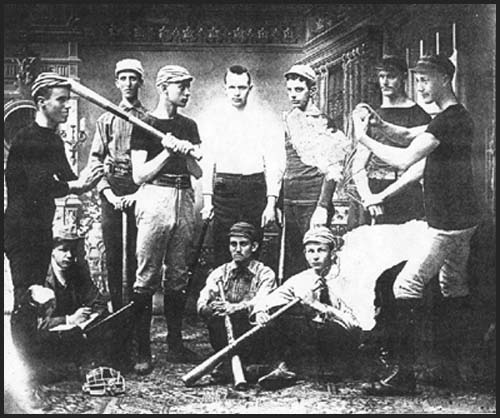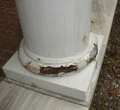
THE EARLY YEARS AT UVM
By John Thomas '98, House Historian
Bert Abbey (far right, "pitching") led the 1888 freshman to victory over the varsity. He later elevated the UVM team from a doormat to a well-tuned powerhouse that was among the best teams in the country.
Lambda Iota brothers Arlington Pond and Bert Abbey were instrumental in establishing baseball at UVM in the late 19th century, and both went on to play for national teams.Abbey entered UVM in 1887 and quickly drew attention for his pitching abilities, specifically his curve ball.
Appointed coach and captain of UVM's team, Abbey elevated the team to a new level of play. He was the first to implement a system of training and take a UVM team through a summer season of play for pay. It was also his well-practiced team that beat Dartmouth at home for the first time.
In 1891, Arlington Pond, a transfer from Norwich University and a fellow Owl in the Lambda Iota Society, joined Abbey on the UVM team. It was the "wonder team" of 1892 that attracted the most attention by beating all college rivals and taking a southern tour in which it took all five games against collegiate competition. The team also challenged two national league teams during this tour, and although it lost both games, the Washington Senators praised them as the "best college team playing baseball."
Abbey became a professional ball player in 1893 with the Washington Senators and over the next four years played for teams in Chicago and Brooklyn. Arlington Pond also became a professional player after graduating from UVM while completing medical school in Baltimore. He joined the Baltimore Orioles in June 1895 and remained with the team until July 1898 when his baseball career was curtailed by the Spanish American War. Sent to the Philippines, Pond remained there the rest of his life, where his medical career eclipsed his fame on the diamond. Especially notable was Pond’s work with Manila's leper population and his success in vaccinating the entire island.
Lambda Iota Society's Arcana Boasts A Proud History
Anyone attending the annual meeting saw how the Arcana continues to reveal documents that challenge the legendary history of the society. Materials found that day have forced a revision of certain popular beliefs about the society and added a new chapter to an already remarkable 165-year history.
Rather than diminishing legends or traditions, thorough examination of the Arcana is bringing a richer, more complex past into focus. For those of you who have told me that you often looked at the Arcana from a distance but never actually waded into its mysteries, the following tells a small part of its story.
Like the society, the contents of the Arcana span 165 years, although the collection actually began in 1839 with the founding of the Lorillard Institute. Benjamin Jewett Tenney wrote the first anonymous communication in the summer of 1839, an essay on smoking that included the first reference to Owls. It was published in the Burlington Sentinel several months before the Lorillard Institute was founded.
The ever-growing collection of literary productions and official records was stored in a box and carted from meeting to meeting, becoming increasingly disorganized with each year. The first effort to organize and index the collection took place in the late 1850s at the advice of the society's first historian, James Noble.
In the late 1840s, records of Phylos Kapnon, including the original charter, the (1836) articles of rebellion, and a year-and-a-half of scribe's records, were given to Lambda Iota for inclusion in the Arcana. The documents, donated by different members of the founding 13, resulted in a new understanding of the society's history. Young Owls learned how the Lorillard Institute and Lambda Iota were products of the earlier organization, information acknowledged or understood by few Owls prior to 1850. Until that time most of the men who are today called the "original 13" were primarily known as honorary members of the Lorillard Institute.
By 1855, the Arcana had become such a valued component of the society that the state charter of Lambda Iota written that same year included a special section on the preservation of the collection in the event of the society's closure. It ordered the university to set aside a space in its library for preservation of the collection for use by Owl alumni. This ensured that the society would not be erased from the institutional history, something the faculty would have been pleased to see.
Although the Arcana has always been at the center of the society, it has not been valued in the same way by each generation. In fact, for some brothers in the late nineteenth century the record of the Owls had become something of an albatross. For example, in the late 1870s one brother proposed burning the entire collection so the society would have more space for meetings and would not have the burden of preservation.
Shortly after that blasphemous suggestion, John Converse commissioned the large cabinet that still holds papers in its cubbies. In those days, the materials in the Arcana were often used to justify different paths for the society. On one hand, old documents supported the argument that the founders were intoxicated rebels, an interpretation that justified the same behavior by the Owls of the 1880s. The same documents in the hands of other Owls could be interpreted as evidence of the founders' scholarship, creativity, and principled independence.
Although that argument (scholarship vs. inebriation) and the Arcana itself continued to grow, the general perusal of the old materials declined after the 1890s. The flowing script, classically inspired subject matter, and political humor of the 1830s, '40s, and '50s had become increasingly opaque with each decade. By 1900, the antiquarians read at meetings were rarely more than five years old. Within the next few years access to the Arcana came under the control of the newly created Fifth Degree, a development that thwarted open exploration of the collection (by non-Fifths), but helped preserve the collection for use today.
The Past Revisited:
History of The Nest's Renovations
Some wonder about the history of the Owl house—has it only recently been in need of major renovation? Indeed not. There have been at least five significant renovations since 1913. One of the largest occurred in 1954 following several years of hard usage after World War II. A fire in the '80s led to the house's being closed for several months while major repairs took place. And, there was the famous time when Lyman Rowell almost single-handedly caused a change in Owlish behavior with resulting significant change in the physical plant.
Different generations of Owls have inherited the house in differing states of repair. And those different generations treated the place with differing levels of stewardship. At times there was a board of governors having at its disposal resources ample to keep the house in tiptop shape. Other boards were constrained by severe financial shortfalls resulting in deferred maintenance.
With ample input from other Owls, the current board decided that this is the time to make renovations that will be longer lasting than others may have been. Not only will money be raised for much-needed repairs and upgrades, but also it will be raised to fund an ongoing maintenance program. New written agreements have been put in place to assure that those who become Owls and who use the house fully understand their responsibilities vis-a-vis the facility and their peers. The decision to employ a live-in house manager further emphasizes the board's commitment.
2011 RENOVATIONS REPORT FOR OWLS' NEST
"As we begin our 175th year, and the house approaches its 100th year, we have expanded the scope of the renovation to essentially 'do everything that makes sense,' exempting only stand-alone projects (such as the kitchens) that can be done at a later date. Short-term interest rates at historical lows have helped our situation."
To read more from Spencer Baker '64 on the renovations, click here.
Visit the Photo Archives for pictures.

